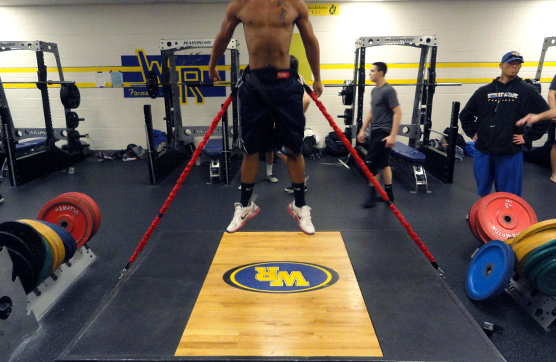Basketball Conditioning: Converting Existing Lifting Platforms to Jump Training Stations

Basketball Conditioning: Converting Existing Lifting Platforms to Jump Training Stations
By Dan Hutchison, MS, ATC, CSCS
Basketball conditioning has always emphasized some of aspect of vertical training to improve jumping ability. Although the long-term goal of the individual is to ‘dunk’ the basketball, many times the ability to leave the earth by just a few extra inches (or centimeters) is sufficient. Basketball consists of many dynamic movements in multiple directions and by improving vertical power, many of these sport applications can be enhanced.
Concepts and equipment within the landscape of the weight room change constantly, unfortunately the budgets associated with most weight rooms, don’t. Adding resources not only for better training, but also to support large teams and diverse physical education (PE) classes, can be an expensive and time-consuming process. As you see in most high school weight rooms, two items are the anchors of the training space – the squat racks and the lifting platforms – and these are typically made of steel or metal products that will last 50 years or more, give-or-take some rust and scratches. To acquisition or purchase items of this magnitude, especially in smaller or budget-restricted schools, can be next to impossible without a bond or some aggressive fund raising. In most cases, administrators will encourage a ‘thrifty’ alternative or a shop-class paint job to cosmetically manipulate the functionality and look, respectively. But, administrators may also appreciate an inexpensive conversion if the price, versatility, and effectiveness are worth it. Perform-X Training Systems has developed a unique and convenient concept for adding jump training applications to existing weight room lifting platforms. The Trak-X™ System is an anchoring device that can be attached to existing lifting platforms to create a station to specifically improve vertical power. Plyometrics can be added in a number of ways to the existing weight room, with the Trak-X™ anchoring system and Perform-X™ Jump Cords offering a safe, versatile, and effective approach to inexpensively adding ‘power training’ to the space.

Advantage of the Trak-X™ and X-Plode™ Cord Systems:
The Trak-X™ System is the most versatile anchoring system that provides easy, safe and effective cord-loading at multiple locations, but specifically can be utilized on existing lifting platforms as a jump training station.
- The Trak-X™ System provides a simple, effective loading mechanism that eliminates pulley systems, ‘choking’ cords around dumbbells or racks, or other unsafe loading applications. The Trak-X™ System provides a simple loading mechanism for all athletic/fitness levels to utilize in multiple ways. The Trak-X™ is simply anchored to the sides or the top of the lifting platform creating a dual cord set up for jump related exercises. Instead of the lifting platforms being ‘one-dimensional’, they now become versatile ‘power stations’ to add to any program or PE class. Other devices may use pulley systems that utilize elastic woven cords for resistance. These devices can be very expensive for just one unit, and offer only one application within the space. These pulley systems do provide a level of safety, but are inconsistent in determining accurate load. Similarly, by utilizing circular bands and ‘choking’ them around dumbbells or squat racks, not only decrease the life and safety of the band, but also lacks a consistent and reliable method of determining load.
- The X-Plode™ Cord product provides consistent variable loading that is more accurate over time. In comparison to an elastic woven cord, rubber tubing provides enhanced loading throughout the range of the stretch with accuracy down to specific pounds per inch (lb. /in.). The properties of rubber tubing allow specific lengthening with a return to the original cord length. Elastic woven cord properties will stretch to a similar degree, but over time may become elongated due to the fabric-based material causing inaccuracies in the loading amounts.
- Utilizing variable resistance training for basketball enhances movement velocity at take-off, and maximizes eccentric loading during landing. The tension characteristics of the rubber tubing provide a unique mechanism for enhancing velocity during the initiation of take-off. By ‘de-loading’ the cords during the take-off phase, athletes/individuals can generate more speed as the feet leave the ground, thus enhancing peak vertical height. This enhanced height forces the athlete/individual to recruit additional muscle fibers during the landing (eccentric) phase, due to an increase in cord load at peak height. The increased velocity at movement initiation, along with additional loading at peak height, enhances power and forces additional control at landing. Two important factors in total athlete/individual development. Plus, when the cords are completely removed from the individual, a ‘contrasting effect’ or potentiation occurs causing an increase or enhancement in muscle stimulation.
- The X-Plode™ Cord System provides accurately measured loads. The X-Plode™ Cords contained in the Trak-X™ Jump-X™ System have 7 progressive resistances that are conveniently charted for the user to better determine load. The starting load is essentially the load that is utilized during the plyometric exercise. A slight decrease in this starting load improves velocity at take-off initiation, and consequently, increases the peak height load to enhance muscle recruitment capacities at landing. These characteristics mimic competitive movements and are superior to constant load methods.
With the retrofit example of anchoring the Trak-X™ to the sides or top of the existing lifting platform, basketball conditioning activities, specifically jumping and landing, can be safely and effectively done within the weight lifting space. The uniqueness of this retrofit model is additional drills can be performed with the anchoring systems while off of the platform area as well. This allows multiple individuals/athletes to be performing a variety of movements both on and off of the platform, but more importantly, creates a new station within the space for basketball power development.
References:
Ebben, W.P. and Jensen, R.L. Electromyographic and Kinetic Analysis of Traditional, Chain, and Elastic Band Squats. JSCR, 16(4): 547-550. 2002.
Joy, J.M., Lowery, R.P., de Souza, E.O., and Wilson, J.M. Elastic Bands as a Component of Periodized Resistance Training. JSCR, 30(8): 2100-2106. 2016.
McClenton, L.S., Brown, L.E., Coburn, J.W., Kersey, R.D. The effect of short-term VertiMax versus depth jump training on vertical jump performance. JSCR, 22(2): 321-325.
Wallace, B.J., Winchester, J.B. and McGuigan, M.R. Effects of Elastic Bands on Force and Power Characteristics during the Back Squat Exercise. JSCR, 20(2): 268-272. 2006.